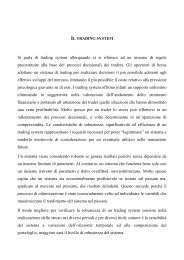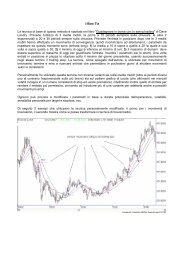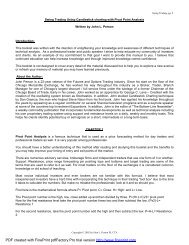Optimal tracking filter - Dimensione Trading
Optimal tracking filter - Dimensione Trading
Optimal tracking filter - Dimensione Trading
Create successful ePaper yourself
Turn your PDF publications into a flip-book with our unique Google optimized e-Paper software.
<strong>Optimal</strong> <strong>tracking</strong> <strong>filter</strong> (OTF)<br />
Si tratta di un indicatore creato de John Ehlers e che, nelle sue intenzioni, dovrebbe sopperire alle<br />
carenze tipiche delle medi mobile tradizionali (con particolare riferimento alle esponenziali): ritardo nella<br />
definizione del segnale di trading, numerosi falsi segnali nelle fasi di trading range, difficoltà nella<br />
determinazione del parametro ottimale su cui lavorare.<br />
A titolo personale ritengo che il vantaggio principale sia di tipo psicologico: non devo scegliere un<br />
parametro standard universalmente valido né verificarne uno (con tutti i problemi del caso) per ogni<br />
mercato o compressione temporale, fattore certamente non da sottovalutare. A part questo i falsi segnali<br />
che caratterizzano le fasi di trading range sono difficilmente eliminabili dai nostri track record, salvo che si<br />
adotti un metodo estremamente conservativo e si eviti di operare fino a che il trend non è identificato su<br />
numerose strutture grafiche (per esempio orario, giornaliero, settimanale); ciò non permette di evitare tutti<br />
i falsi segnali, chiaramente, ma ne limita certamente il numero, comportando tuttavia un maggior rischio in<br />
particolare nell’entità degli stop loss ed in una potenziale riduzione del profitto di lungo periodo.<br />
Tornando al discorso direi che preferisco aggiungere qualche grafico per dare un’idea del funzionamento<br />
dell’ OTF sul grafico dei prezzi, lasciando invece la spiegazione più completa allo scritto originale<br />
riportato sotto (in inglese: chi non lo mastica sufficientemente bene lo può tradurre anche con google, dà<br />
un risultato più che accettabile in questo caso).<br />
Grafico1<br />
Evidente l’ottimo funzionamento dell’indicatore nelle fasi direzionali; la stessa situazione, tuttavia, la si<br />
può verificare positivamente anche con l’adozione di una semplice media mobile esponenziale; come<br />
detto sopra, tuttavia, usare una media comporta necessariamente la definizione di un parametro<br />
temporale la cui scelta avrà carattere soggettivo o sarà legata alle aspettative di profitto del trader. Con<br />
l’OTF il problema non si pone, ovviamente.
Grafici 2 e 3
Qui sopra si nota come, nelle fasi laterali, il numero di falsi segnali, a mio parere, non diminuisce in<br />
misura tale da giustificarne in modo assoluto ed a carattere definitivo rispetto ad una media mobile (in<br />
questo caso parametro 10, esponenziale). Infine, l’ultimo grafico mostra come, eventualmente,<br />
l’indicatore potrebbe essere parte di una semplicissima metodologia di trading se accoppiato ad un<br />
classico stocastico: si opera al ribasso con oscillatore stocastico in ipercomprato (al momento o di<br />
recente) e chiusura della candela sotto l’indicatore OTF, viceversa al rialzo.<br />
Sotto la spiegazione, completata dal codice in easy language per chi utilizzasse Tradestation.<br />
INTRODUCTION<br />
OPTIMAL TRACKING FILTERS<br />
By<br />
John Ehlers<br />
Dr. R.E. Kalman introduced his concept of optimum estimation in 1960. Since that time, his technique<br />
has proven to be a powerful and practical tool. The approach is particularly well suited for optimizing the<br />
performance of modern terrestrial and space navigation systems. Many traders not directly involved in<br />
system analysis have heard about Kalman <strong>filter</strong>ing and have expressed an interest in learning more about<br />
it for market applications. Although attempts have been made to provide simple, intuitive explanations,<br />
none has been completely successful. Almost without exception, descriptions have become mired in the<br />
jargon and state-space notation of the “cult”.<br />
Surprisingly, in spite of the obscure-looking mathematics (the most impenetrable of which can be<br />
found in Dr. Kalman’s original paper), Kalman <strong>filter</strong>ing is a fairly direct and simple concept. In the spirit of<br />
being pragmatic, we will not deal with the full-blown matrix equations in this description and we will be<br />
less than rigorous in the application to trading. Rigorous application requires knowledge of the probability<br />
distributions of the statistics. Nonetheless we end with practically useful results. We will depart from the<br />
classical approach by working backwards from Exponential Moving Averages. In this process, we<br />
introduce a way to create a nearly zero lag moving average. From there, we will use the concept of a<br />
Tracking Index that optimizes the <strong>filter</strong> <strong>tracking</strong> for the given uncertainty in price movement and the<br />
uncertainty in our ability to measure it.<br />
SUB-OPTIMAL FILTERS<br />
Tracking <strong>filter</strong>s are used to estimate the position of a target using a linear model. Equation 1,<br />
called an Alpha <strong>filter</strong>, shows that this model is comprised of using the previous estimate plus a constant<br />
times the difference between the last real position and the last estimate.<br />
X^ = X^[1] + (Z – X^[1])<br />
Where X^ is the estimated next position<br />
Z is the last real position<br />
But this is exactly the same thing as the Exponential Moving Average (EMA) with which you are familiar. I<br />
prefer to rearrange the terms so that the EMA is written as:<br />
EMA = *Price + (1 – )*EMA[1]<br />
As you know, this equation for the EMA produces a lag in the estimated price. We can improve our<br />
estimate of position by adding an estimate of the velocity to the last known position in Equation 1.<br />
Equation 1 then becomes:
X^ = X^[1] + ((Z + K*V^) – X^[1])<br />
Where V^ is the velocity estimate<br />
K is a gain factor<br />
In general, the velocity estimate is an EMA of the rate of change of position, so that:<br />
V^ = V^[1] + (V – V^[1])<br />
This is the Beta part of an Alpha-Beta <strong>filter</strong>.<br />
We can create a near zero lag <strong>filter</strong> for the special case where b = 1. In this case, equation 2 can<br />
be written as:<br />
ZEMA = *(Price + K*(Price – Price[4])) + (1 – )*ZEMA[1]<br />
I took the liberty of using the four day “Momentum” (a misnomer if ever there was one) as the velocity<br />
estimate. Figure 1 shows the EMA using = 0.25 compared to the ZEMA using the same alpha and K =<br />
0.5. This is not a bad “zero lag” <strong>filter</strong>, even if it is sub-optimal.<br />
MATHEMATICAL MODEL<br />
Now that you are a little familiar with the model of target motion, the more general linear ideal<br />
model is<br />
y = y[1] + w[1]<br />
where y[1] is the target state vector at time [1], is the state transition matrix, w[1] is the unknown target<br />
maneuver, and is the maneuver/state transition matrix. The performance of the estimation process is<br />
determined by the statistical characteristic of the estimation process. Since this system is linear and the<br />
noise processes are assumed to be white, the optimal mean-squared-error is the Kalman <strong>filter</strong>. There are<br />
errors in both the uncertainty of the maneuver and the uncertainty in the position measurement. Kalata 1<br />
has introduced the concept of a Tracking Index, . He defines the Tracking Index as:<br />
= (position maneuverability uncertainty) / (position measurement uncertainty)<br />
We will return to the interpretation of the Tracking Index to price charts, but for now we will complete our<br />
mathematical model. Given that is given, it implicitly specifies the optimal steady state solution.<br />
Grinding through the math, the solution for the alpha <strong>filter</strong> is:<br />
8)<br />
We use the same alpha for an alpha-beta <strong>filter</strong>, and additionally have the relationship:<br />
9)<br />
α =<br />
− Λ<br />
2<br />
4 2<br />
( Λ + 16Λ<br />
)<br />
8<br />
COMPUTING THE TRACKING INDEX<br />
+<br />
β =<br />
2( 2 − α)<br />
− 4 ( 1 − α)<br />
1 Paul R. Kalata, “The Tracking Index: A Generalized Parameter for α−β and α−β−γ Target Trackers”,<br />
IEEE Transactions on Aerospace and Electronic Systems”, Vol AES-20, No.2, March 1984, p 174-182
Under steady state conditions the position maneuverability uncertainty is just the bar-to-bar variation of<br />
the mid range of the price bars. The measurement uncertainty is half the high-to-low range of the price<br />
bar. Simple enough. As a practical matter, is it better to take the Exponential Moving Averages of these<br />
two measurements to keep the Tracking Factor from going completely crazy. A smoothing constant of .2<br />
results in reasonable a four bar lag 2 in both the numerator and denominator, fundamentally canceling lag<br />
in the ratio. Therefore, the simplified equations for the Tracking Factor in terms of the price is:<br />
A = .2*((H+L)/2 – (H[1]+L[1])/2) + .8*A[1]<br />
B = .2*(H-L)/2 + .8*B[1]<br />
= A / B<br />
The EasyLanguage source code for an optimal <strong>tracking</strong> <strong>filter</strong> is given in SideBar1.<br />
************************************** SideBar 1 *******************************************<br />
EasyLanguage Code for an <strong>Optimal</strong> Tracking Filter<br />
inputs: Price((h+l)/2);<br />
vars: lambda(0),<br />
alpha(0);<br />
Value1 = .2*(Price - Price[1]) + .8*Value1[1];<br />
Value2 = .1*(H - L) + .8*Value2[1];<br />
if Value2 0 then lambda = AbsValue(Value1 / Value2);<br />
alpha = ( -lambda*lambda + SquareRoot(lambda*lambda*lambda*lambda + 16*lambda*lambda)) /8;<br />
Value3 = alpha*Price + (1-alpha)*Value3[1];<br />
Plot1(Value3, "AlphaTrack");<br />
2 John Ehlers, “Signal Analysis Concepts”









